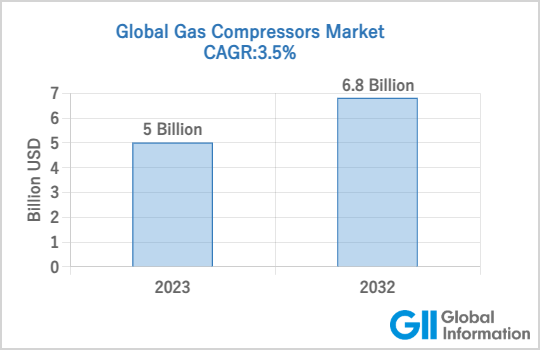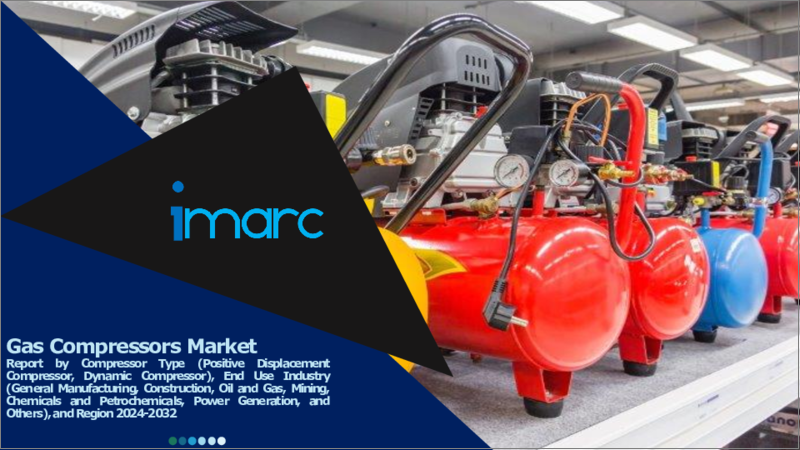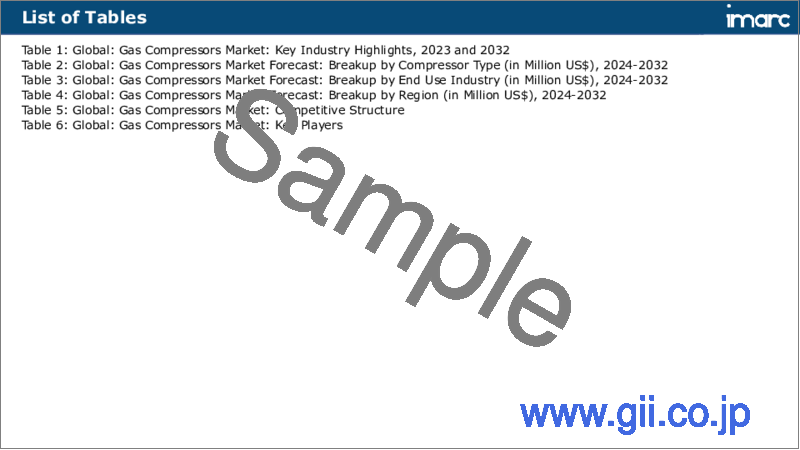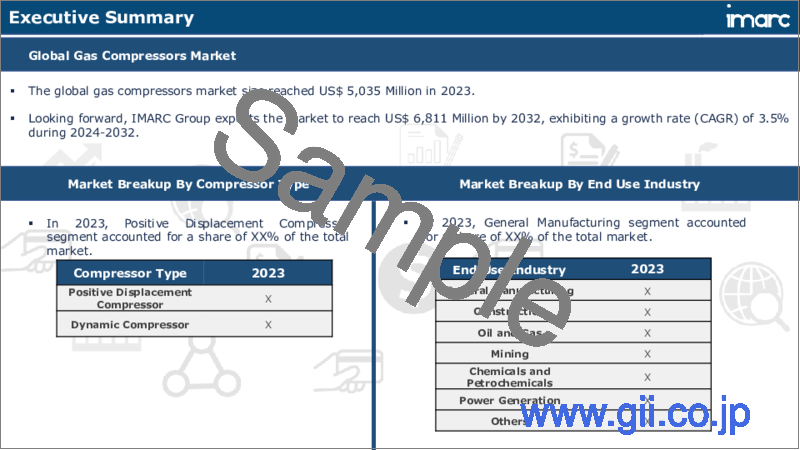|
|
市場調査レポート
商品コード
1541480
ガス圧縮機の市場レポート:圧縮機タイプ、最終用途産業、地域別、2024~2032年Gas Compressors Market Report by Compressor Type, End Use Industry, and Region 2024-2032 |
||||||
カスタマイズ可能
|
|||||||
| ガス圧縮機の市場レポート:圧縮機タイプ、最終用途産業、地域別、2024~2032年 |
|
出版日: 2024年08月10日
発行: IMARC
ページ情報: 英文 141 Pages
納期: 2~3営業日
|
- 全表示
- 概要
- 図表
- 目次
世界のガス圧縮機の市場規模は2023年に50億米ドルに達しました。今後、IMARC Groupは、市場は2032年までに68億米ドルに達し、2024~2032年の間に3.5%の成長率(CAGR)を示すと予測しています。よりクリーンなエネルギー源としての天然ガス需要の増加、産業活動の拡大、コンプレッサー設計の技術的進歩、厳しい環境規制、未開拓地域での探査努力の高まり、インフラ投資の増加が市場成長の原動力となっています。

ガスコンプレッサは、体積を減少させることでガスの圧力を高めるように設計された機械装置です。エネルギー、製造、輸送など様々な産業で重要な役割を果たしています。ガス・コンプレッサーは通常、モーター、コンプレッサー・ユニット、制御システムなどの部品で構成されています。このプロセスでは、気体を吸い込み、その後、容積式または動圧式で圧縮します。容積式コンプレッサーは、往復ピストンやロータリースクリューのような機構を使用してガスを捕捉し、体積を減少させます。一方、動的コンプレッサーは、遠心力のような技術を利用してガスを加速し、圧縮します。ガスコンプレッサーの利点は、輸送効率の向上、貯蔵容量の増加、さまざまな工業プロセスの促進など多岐にわたります。その用途は、空気圧工具の動力源から長距離の天然ガス輸送の補助まで多岐にわたります。大きく分けて、ガスコンプレッサは容積式コンプレッサと動的コンプレッサの2つに分類されます。
世界のガス圧縮機の市場は、よりクリーンなエネルギー源としての天然ガス需要の高まりと、石油・ガス、製造、石油化学などのセクターにわたる産業活動の拡大に影響されています。さらに、特にレシプロコンプレッサーと遠心式コンプレッサーの設計における技術の進歩が、市場の成長を増大させています。これに伴い、厳しい環境規制が、排出を最小限に抑え、コンプライアンスを確保するコンプレッサーの採用を促し、市場の成長をさらに後押ししています。これとは別に、未開拓地域での探査・生産活動の活発化、インフラ開拓への投資の増加、再生可能エネルギー源へのシフトが市場成長を後押ししています。
ガス圧縮機の市場傾向/促進要因
天然ガス需要の増加
世界のガス圧縮機の市場は、環境に優しい代替エネルギーとしての天然ガス需要の高まりに大きく後押しされています。各国が二酸化炭素排出量の削減に努める中、天然ガスは従来の化石燃料に比べて二酸化炭素排出量が少ないため、重要な移行燃料として浮上しています。この需要急増の背景には、気候変動目標を遵守しながらエネルギー需要を満たしたいという願望があります。ガスコンプレッサは、天然ガスの抽出、輸送、流通において極めて重要な役割を果たしています。効率的な圧縮を実現し、パイプラインや貯蔵施設でのシームレスな移動を可能にします。各国がよりクリーンなエネルギー源への移行を続ける中、この原動力は揺るぎないと予想されます。
産業活動の拡大
石油・ガス、製造業、石油化学などのセクターにおける産業活動の拡大は、世界のガス圧縮機の市場の大きな推進力となっています。これらの産業は、空気圧工具、空調、冷凍などの様々なプロセスで圧縮ガスに大きく依存しています。工業化が進むにつれて、圧縮ガスの需要は増大し、信頼性が高く効率的な圧縮ソリューションが必要とされています。ガスコンプレッサは、重要なプロセスを最適に機能させ、生産能力の向上をサポートします。このことは、世界中の産業活動の円滑な運営を維持する上で、ガスコンプレッサが重要な役割を果たしていることを示しています。
コンプレッサー技術の進歩
コンプレッサー技術、特にレシプロコンプレッサーと遠心コンプレッサーの設計の進歩は、世界のガス圧縮機の市場の軌道を形成する上で重要です。エンジニアとメーカーは、コンプレッサーの効率、性能、信頼性を高めるために絶えず技術革新を行っています。最先端の設計には、可変速駆動、改善された材料、強化されたシーリング機構などの機能が組み込まれており、その結果、効率が向上し、メンテナンス要件が低減しています。このような技術的進歩は、圧縮プロセスの全体的な効率を高めるだけでなく、特定の業界のニーズを満たすカスタマイズを可能にします。エネルギー消費を最小限に抑えながら優れた性能を発揮するコンプレッサーの需要が高まる中、コンプレッサー技術の進化は、市場の成長と開拓の極めて重要な原動力となっています。
目次
第1章 序文
第2章 調査範囲と調査手法
- 調査の目的
- ステークホルダー
- データソース
- 一次情報
- 二次情報
- 市場推定
- ボトムアップアプローチ
- トップダウンアプローチ
- 調査手法
第3章 エグゼクティブサマリー
第4章 イントロダクション
- 概要
- 主要業界動向
第5章 世界のガス圧縮機市場
- 市場概要
- 市場実績
- COVID-19の影響
- 市場予測
第6章 市場内訳:コンプレッサータイプ別
- 容積式コンプレッサー
- ダイナミックコンプレッサー
第7章 市場内訳:最終用途産業別
- 一般製造業
- 建設
- 石油・ガス
- 鉱業
- 化学と石油化学製品
- 発電
- その他
第8章 市場内訳:地域別
- 北米
- 米国
- カナダ
- アジア太平洋
- 中国
- 日本
- インド
- 韓国
- オーストラリア
- インドネシア
- その他
- 欧州
- ドイツ
- フランス
- 英国
- イタリア
- スペイン
- ロシア
- その他
- ラテンアメリカ
- ブラジル
- メキシコ
- その他
- 中東・アフリカ
- 市場動向
- 市場内訳:国別
- 市場予測
第9章 SWOT分析
- 概要
- 強み
- 弱み
- 機会
- 脅威
第10章 バリューチェーン分析
第11章 ポーターのファイブフォース分析
- 概要
- 買い手の交渉力
- 供給企業の交渉力
- 競合の程度
- 新規参入業者の脅威
- 代替品の脅威
第12章 価格分析
第13章 競合情勢
- 市場構造
- 主要企業
- 主要企業のプロファイル
- Ariel Corporation
- Atlas Copco AB
- Bauer Compressors Inc.
- Burckhardt Compression Holding AG
- Exterran Corporation
- Gardner Denver Inc.
- General Electric Company
- Hitachi Ltd.
- Kobelco
- Siemens AG
List of Figures
- Figure 1: Global: Gas Compressors Market: Major Drivers and Challenges
- Figure 2: Global: Gas Compressors Market: Sales Value (in Billion US$), 2018-2023
- Figure 3: Global: Gas Compressors Market Forecast: Sales Value (in Billion US$), 2024-2032
- Figure 4: Global: Gas Compressors Market: Breakup by Compressor Type (in %), 2023
- Figure 5: Global: Gas Compressors Market: Breakup by End Use Industry (in %), 2023
- Figure 6: Global: Gas Compressors Market: Breakup by Region (in %), 2023
- Figure 7: Global: Gas Compressors (Positive Displacement Compressor) Market: Sales Value (in Million US$), 2018 & 2023
- Figure 8: Global: Gas Compressors (Positive Displacement Compressor) Market Forecast: Sales Value (in Million US$), 2024-2032
- Figure 9: Global: Gas Compressors (Dynamic Compressor) Market: Sales Value (in Million US$), 2018 & 2023
- Figure 10: Global: Gas Compressors (Dynamic Compressor) Market Forecast: Sales Value (in Million US$), 2024-2032
- Figure 11: Global: Gas Compressors (General Manufacturing) Market: Sales Value (in Million US$), 2018 & 2023
- Figure 12: Global: Gas Compressors (General Manufacturing) Market Forecast: Sales Value (in Million US$), 2024-2032
- Figure 13: Global: Gas Compressors (Construction) Market: Sales Value (in Million US$), 2018 & 2023
- Figure 14: Global: Gas Compressors (Construction) Market Forecast: Sales Value (in Million US$), 2024-2032
- Figure 15: Global: Gas Compressors (Oil and Gas) Market: Sales Value (in Million US$), 2018 & 2023
- Figure 16: Global: Gas Compressors (Oil and Gas) Market Forecast: Sales Value (in Million US$), 2024-2032
- Figure 17: Global: Gas Compressors (Mining) Market: Sales Value (in Million US$), 2018 & 2023
- Figure 18: Global: Gas Compressors (Mining) Market Forecast: Sales Value (in Million US$), 2024-2032
- Figure 19: Global: Gas Compressors (Chemicals and Petrochemicals) Market: Sales Value (in Million US$), 2018 & 2023
- Figure 20: Global: Gas Compressors (Chemicals and Petrochemicals) Market Forecast: Sales Value (in Million US$), 2024-2032
- Figure 21: Global: Gas Compressors (Power Generation) Market: Sales Value (in Million US$), 2018 & 2023
- Figure 22: Global: Gas Compressors (Power Generation) Market Forecast: Sales Value (in Million US$), 2024-2032
- Figure 23: Global: Gas Compressors (Other End Use Industries) Market: Sales Value (in Million US$), 2018 & 2023
- Figure 24: Global: Gas Compressors (Other End Use Industries) Market Forecast: Sales Value (in Million US$), 2024-2032
- Figure 25: North America: Gas Compressors Market: Sales Value (in Million US$), 2018 & 2023
- Figure 26: North America: Gas Compressors Market Forecast: Sales Value (in Million US$), 2024-2032
- Figure 27: United States: Gas Compressors Market: Sales Value (in Million US$), 2018 & 2023
- Figure 28: United States: Gas Compressors Market Forecast: Sales Value (in Million US$), 2024-2032
- Figure 29: Canada: Gas Compressors Market: Sales Value (in Million US$), 2018 & 2023
- Figure 30: Canada: Gas Compressors Market Forecast: Sales Value (in Million US$), 2024-2032
- Figure 31: Asia-Pacific: Gas Compressors Market: Sales Value (in Million US$), 2018 & 2023
- Figure 32: Asia-Pacific: Gas Compressors Market Forecast: Sales Value (in Million US$), 2024-2032
- Figure 33: China: Gas Compressors Market: Sales Value (in Million US$), 2018 & 2023
- Figure 34: China: Gas Compressors Market Forecast: Sales Value (in Million US$), 2024-2032
- Figure 35: Japan: Gas Compressors Market: Sales Value (in Million US$), 2018 & 2023
- Figure 36: Japan: Gas Compressors Market Forecast: Sales Value (in Million US$), 2024-2032
- Figure 37: India: Gas Compressors Market: Sales Value (in Million US$), 2018 & 2023
- Figure 38: India: Gas Compressors Market Forecast: Sales Value (in Million US$), 2024-2032
- Figure 39: South Korea: Gas Compressors Market: Sales Value (in Million US$), 2018 & 2023
- Figure 40: South Korea: Gas Compressors Market Forecast: Sales Value (in Million US$), 2024-2032
- Figure 41: Australia: Gas Compressors Market: Sales Value (in Million US$), 2018 & 2023
- Figure 42: Australia: Gas Compressors Market Forecast: Sales Value (in Million US$), 2024-2032
- Figure 43: Indonesia: Gas Compressors Market: Sales Value (in Million US$), 2018 & 2023
- Figure 44: Indonesia: Gas Compressors Market Forecast: Sales Value (in Million US$), 2024-2032
- Figure 45: Others: Gas Compressors Market: Sales Value (in Million US$), 2018 & 2023
- Figure 46: Others: Gas Compressors Market Forecast: Sales Value (in Million US$), 2024-2032
- Figure 47: Europe: Gas Compressors Market: Sales Value (in Million US$), 2018 & 2023
- Figure 48: Europe: Gas Compressors Market Forecast: Sales Value (in Million US$), 2024-2032
- Figure 49: Germany: Gas Compressors Market: Sales Value (in Million US$), 2018 & 2023
- Figure 50: Germany: Gas Compressors Market Forecast: Sales Value (in Million US$), 2024-2032
- Figure 51: France: Gas Compressors Market: Sales Value (in Million US$), 2018 & 2023
- Figure 52: France: Gas Compressors Market Forecast: Sales Value (in Million US$), 2024-2032
- Figure 53: United Kingdom: Gas Compressors Market: Sales Value (in Million US$), 2018 & 2023
- Figure 54: United Kingdom: Gas Compressors Market Forecast: Sales Value (in Million US$), 2024-2032
- Figure 55: Italy: Gas Compressors Market: Sales Value (in Million US$), 2018 & 2023
- Figure 56: Italy: Gas Compressors Market Forecast: Sales Value (in Million US$), 2024-2032
- Figure 57: Spain: Gas Compressors Market: Sales Value (in Million US$), 2018 & 2023
- Figure 58: Spain: Gas Compressors Market Forecast: Sales Value (in Million US$), 2024-2032
- Figure 59: Russia: Gas Compressors Market: Sales Value (in Million US$), 2018 & 2023
- Figure 60: Russia: Gas Compressors Market Forecast: Sales Value (in Million US$), 2024-2032
- Figure 61: Others: Gas Compressors Market: Sales Value (in Million US$), 2018 & 2023
- Figure 62: Others: Gas Compressors Market Forecast: Sales Value (in Million US$), 2024-2032
- Figure 63: Latin America: Gas Compressors Market: Sales Value (in Million US$), 2018 & 2023
- Figure 64: Latin America: Gas Compressors Market Forecast: Sales Value (in Million US$), 2024-2032
- Figure 65: Brazil: Gas Compressors Market: Sales Value (in Million US$), 2018 & 2023
- Figure 66: Brazil: Gas Compressors Market Forecast: Sales Value (in Million US$), 2024-2032
- Figure 67: Mexico: Gas Compressors Market: Sales Value (in Million US$), 2018 & 2023
- Figure 68: Mexico: Gas Compressors Market Forecast: Sales Value (in Million US$), 2024-2032
- Figure 69: Others: Gas Compressors Market: Sales Value (in Million US$), 2018 & 2023
- Figure 70: Others: Gas Compressors Market Forecast: Sales Value (in Million US$), 2024-2032
- Figure 71: Middle East and Africa: Gas Compressors Market: Sales Value (in Million US$), 2018 & 2023
- Figure 72: Middle East and Africa: Gas Compressors Market: Breakup by Country (in %), 2023
- Figure 73: Middle East and Africa: Gas Compressors Market Forecast: Sales Value (in Million US$), 2024-2032
- Figure 74: Global: Gas Compressors Industry: SWOT Analysis
- Figure 75: Global: Gas Compressors Industry: Value Chain Analysis
- Figure 76: Global: Gas Compressors Industry: Porter's Five Forces Analysis
List of Tables
- Table 1: Global: Gas Compressors Market: Key Industry Highlights, 2023 and 2032
- Table 2: Global: Gas Compressors Market Forecast: Breakup by Compressor Type (in Million US$), 2024-2032
- Table 3: Global: Gas Compressors Market Forecast: Breakup by End Use Industry (in Million US$), 2024-2032
- Table 4: Global: Gas Compressors Market Forecast: Breakup by Region (in Million US$), 2024-2032
- Table 5: Global: Gas Compressors Market: Competitive Structure
- Table 6: Global: Gas Compressors Market: Key Players
The global gas compressors market size reached US$ 5.0 Billion in 2023. Looking forward, IMARC Group expects the market to reach US$ 6.8 Billion by 2032, exhibiting a growth rate (CAGR) of 3.5% during 2024-2032. Increasing demand for natural gas as a cleaner energy source, expanding industrial activities, technological advancements in compressor designs, stringent environmental regulations, growing exploration efforts in untapped regions, and rising infrastructure investments are fueling the market growth.
Gas compressors are mechanical devices designed to increase the pressure of a gas by reducing its volume. They play a crucial role in various industries, including energy, manufacturing, and transportation. Gas compressors are typically composed of components such as a motor, compressor unit, and control system. The process involves drawing in gas and subsequently compressing it using either positive displacement or dynamic methods. Positive displacement compressors use mechanisms like reciprocating pistons or rotary screws to trap and reduce gas volume, while dynamic compressors utilize techniques like centrifugal force to accelerate and compress gas. Advantages of gas compressors encompass enhanced transport efficiency, increased storage capacity, and the facilitation of various industrial processes. Their application spans from powering pneumatic tools to aiding in natural gas transportation over long distances. Broadly, gas compressors fall into two main categories: positive displacement and dynamic compressors.
The global gas compressors market is influenced by the rising demand for natural gas as a cleaner energy source and the expanding industrial activities across sectors, such as oil and gas, manufacturing, and petrochemicals. Moreover, advancements in technology, particularly in reciprocating and centrifugal compressor designs, is augmenting market growth. In line with this, stringent environmental regulations encourage the adoption of compressors that minimize emissions and ensure compliance, further supporting market growth. Apart from this, the growing exploration and production activities in untapped regions, increasing investments in infrastructure development, and the shift towards renewable energy sources are propelling market growth.
Gas Compressors Market Trends/Drivers:
Rising demand for natural gas
The global gas compressors market is significantly propelled by the escalating demand for natural gas as an environmentally friendly energy alternative. As nations strive to reduce their carbon footprint, natural gas has emerged as a key transition fuel due to its lower carbon emissions compared to conventional fossil fuels. This demand surge is driven by the desire to meet energy needs while adhering to climate goals. Gas compressors play a pivotal role in the extraction, transportation, and distribution of natural gas. They ensure efficient compression, enabling seamless movement through pipelines and storage facilities. This driver is expected to remain steadfast as countries continue to transition towards cleaner energy sources.
Expanding industrial activities
The expansion of industrial activities across sectors such as oil and gas, manufacturing, and petrochemicals acts as a substantial driver for the global gas compressors market. These industries heavily rely on compressed gases for various processes, such as pneumatic tools, air conditioning, refrigeration, and more. As industrialization continues to flourish, the demand for compressed gases escalates, necessitating reliable and efficient compression solutions. Gas compressors ensure the optimal functioning of essential processes, supporting increased production capacities. This driver underscores the essential role that gas compressors play in maintaining the smooth operation of industrial activities worldwide.
Advancements in compressor technology
Advancements in compressor technology, particularly in reciprocating and centrifugal compressor designs, are instrumental in shaping the trajectory of the global gas compressors market. Engineers and manufacturers are continuously innovating to enhance compressor efficiency, performance, and reliability. Cutting-edge designs incorporate features like variable speed drives, improved materials, and enhanced sealing mechanisms, resulting in higher efficiency and reduced maintenance requirements. These technological advancements not only boost the overall efficiency of compression processes but also enable customization to meet specific industry needs. As industries increasingly demand compressors that deliver superior performance while minimizing energy consumption, the evolution of compressor technology remains a pivotal driver in the market's growth and development.
Gas Compressors Industry Segmentation:
IMARC Group provides an analysis of the key trends in each segment of the global gas compressors market report, along with forecasts at the global, regional, and country levels for 2024-2032. Our report has categorized the market based on compressor type and end use industry.
Breakup by Compressor Type:
Positive Displacement Compressor
Dynamic Compressor
Positive displacement compressor dominates the market
The report has provided a detailed breakup and analysis of the market based on the compressor type. This includes positive displacement compressor and dynamic compressor. According to the report, positive displacement compressor represented the largest segment.
The positive displacement compressor segment is influenced by several key factors, which includes its inherent ability to deliver a consistent flow of compressed gas regardless of discharge pressure variations. Moreover, the versatility of positive displacement compressors in handling a wide range of gases, including viscous and high-pressure gases, expands their applicability across diverse sectors such as petrochemicals, manufacturing, and pharmaceuticals. In line with this, the simplicity of design and ease of maintenance of positive displacement compressors attract industries looking for efficient yet straightforward solutions. Furthermore, their capability to deliver high compression ratios makes them suitable for applications requiring specific pressure levels. Additionally, the segment benefits from ongoing technological advancements, which enhance their efficiency and performance while addressing environmental concerns.
Breakup by End Use Industry:
General Manufacturing
Construction
Oil and Gas
Mining
Chemicals and Petrochemicals
Power Generation
Others
Oil and gas dominates the market
The report has provided a detailed breakup and analysis of the market based on the end use industry. This includes general manufacturing, construction, oil and gas, mining, chemicals and petrochemicals, power generation, and others. According to the report, oil and gas represented the largest segment.
The oil and gas segment is accelerated by a confluence of key factors, including the burgeoning global energy, especially in sectors such as transportation, manufacturing, and power generation. As economies grow and modernize, the need for these fuels remains essential. Moreover, exploration and production activities in untapped regions, including deep-sea reserves and unconventional sources like shale, drive investments in the oil and gas sector. Apart from this, geopolitical factors, such as supply disruptions and political tensions, influence market volatility and pricing. Furthermore, advancements in drilling technologies enhance efficiency, enabling the extraction of oil and gas from increasingly challenging environments. In line with this, the ongoing demand for petrochemical products fuels the need for feedstock, further anchoring the oil and gas segment.
Breakup by Region:
North America
United States
Canada
Asia-Pacific
China
Japan
India
South Korea
Australia
Indonesia
Others
Europe
Germany
France
United Kingdom
Italy
Spain
Russia
Others
Latin America
Brazil
Mexico
Others
Middle East and Africa
Asia Pacific exhibits a clear dominance, accounting for the largest gas compressors market share
The market research report has also provided a comprehensive analysis of all the major regional markets, which include North America (the United States and Canada); Europe (Germany, France, the United Kingdom, Italy, Spain, Russia, and others); Asia Pacific (China, Japan, India, South Korea, Australia, Indonesia, and others); Latin America (Brazil, Mexico, and others); and the Middle East and Africa. According to the report, Asia Pacific accounted for the largest market share.
The Asia Pacific gas compressors market is being propelled by a confluence of factors, including rapid industrialization in countries like China, India, and Southeast Asian nations, which is driving demand for efficient compression solutions across manufacturing, petrochemicals, and energy sectors. This trend is reinforced by the shift towards clean energy, with gas compressors playing a vital role in distributing natural gas as a substitute for coal. The region's expanding energy sector, encompassing exploration, production, and refining, further augments compressor demand, ensuring a steady gas supply to power plants and industries. The burgeoning liquefied natural gas (LNG) industry in the region relies heavily on compressors for production, storage, and transportation. Technological advancements in compressor designs and digital solutions, such as IoT integration and data analytics, are fostering innovation and optimizing operational efficiency in the market. Manufacturers are actively tailoring compression solutions to regional needs, driving sustainable growth in the Asia Pacific gas compressors market.
Competitive Landscape:
The competitive landscape of the global gas compressors market is characterized by intense rivalry among key industry players striving to secure a significant market share. Companies compete not only based on product quality and performance but also on factors such as technological innovation, pricing strategies, and comprehensive after-sales services. The industry's growth is further fueled by a constant drive for research and development, leading to the introduction of advanced and energy-efficient compressor technologies. Market participants focus on enhancing their global footprint through strategic partnerships, collaborations, and acquisitions to expand their market presence and customer base. As the demand for cleaner energy solutions continues to rise, competition is driven by the need to offer environmentally sustainable compressor solutions that align with evolving regulatory standards. Amidst these factors, differentiation through product diversification and a strong emphasis on customer relationships remain central to gaining a competitive edge in this dynamic and evolving market landscape.
The report has provided a comprehensive analysis of the competitive landscape in the market. Detailed profiles of all major companies have also been provided. Some of the key players in the market include:
Ariel Corporation
Atlas Copco AB
Bauer Compressors Inc.
Burckhardt Compression Holding AG
Exterran Corporation
Gardner Denver Inc.
General Electric Company
Hitachi Ltd.
Kobelco
Siemens AG
Recent Developments:
In January 2023, Enerflex closed its $735 million acquisition of Exterran, a major natural gas processing company.
In August 2023, Atlas Copco's announced a new factory in Talegaon that will manufacture air and gas compressor systems for the local market, and for export. It encompasses a manufacturing plant and office building of approximately 25,000 m2.
In August 2023, Siemens AG announced to have entered into an agreement to acquire Heliox, a Netherlands-based company.
Key Questions Answered in This Report
- 1. What was the size of the global gas compressors market in 2023?
- 2. What is the expected growth rate of the global gas compressors market during 2024-2032?
- 3. What are the key factors driving the global gas compressors market?
- 4. What has been the impact of COVID-19 on the global gas compressors market?
- 5. What is the breakup of the global gas compressors market based on the compressor type?
- 6. What is the breakup of the global gas compressors market based on the end use industry?
- 7. What are the key regions in the global gas compressors market?
- 8. Who are the key players/companies in the global gas compressors market?
Table of Contents
1 Preface
2 Scope and Methodology
- 2.1 Objectives of the Study
- 2.2 Stakeholders
- 2.3 Data Sources
- 2.3.1 Primary Sources
- 2.3.2 Secondary Sources
- 2.4 Market Estimation
- 2.4.1 Bottom-Up Approach
- 2.4.2 Top-Down Approach
- 2.5 Forecasting Methodology
3 Executive Summary
4 Introduction
- 4.1 Overview
- 4.2 Key Industry Trends
5 Global Gas Compressors Market
- 5.1 Market Overview
- 5.2 Market Performance
- 5.3 Impact of COVID-19
- 5.4 Market Forecast
6 Market Breakup by Compressor Type
- 6.1 Positive Displacement Compressor
- 6.1.1 Market Trends
- 6.1.2 Market Forecast
- 6.2 Dynamic Compressor
- 6.2.1 Market Trends
- 6.2.2 Market Forecast
7 Market Breakup by End Use Industry
- 7.1 General Manufacturing
- 7.1.1 Market Trends
- 7.1.2 Market Forecast
- 7.2 Construction
- 7.2.1 Market Trends
- 7.2.2 Market Forecast
- 7.3 Oil and Gas
- 7.3.1 Market Trends
- 7.3.2 Market Forecast
- 7.4 Mining
- 7.4.1 Market Trends
- 7.4.2 Market Forecast
- 7.5 Chemicals and Petrochemicals
- 7.5.1 Market Trends
- 7.5.2 Market Forecast
- 7.6 Power Generation
- 7.6.1 Market Trends
- 7.6.2 Market Forecast
- 7.7 Others
- 7.7.1 Market Trends
- 7.7.2 Market Forecast
8 Market Breakup by Region
- 8.1 North America
- 8.1.1 United States
- 8.1.1.1 Market Trends
- 8.1.1.2 Market Forecast
- 8.1.2 Canada
- 8.1.2.1 Market Trends
- 8.1.2.2 Market Forecast
- 8.1.1 United States
- 8.2 Asia-Pacific
- 8.2.1 China
- 8.2.1.1 Market Trends
- 8.2.1.2 Market Forecast
- 8.2.2 Japan
- 8.2.2.1 Market Trends
- 8.2.2.2 Market Forecast
- 8.2.3 India
- 8.2.3.1 Market Trends
- 8.2.3.2 Market Forecast
- 8.2.4 South Korea
- 8.2.4.1 Market Trends
- 8.2.4.2 Market Forecast
- 8.2.5 Australia
- 8.2.5.1 Market Trends
- 8.2.5.2 Market Forecast
- 8.2.6 Indonesia
- 8.2.6.1 Market Trends
- 8.2.6.2 Market Forecast
- 8.2.7 Others
- 8.2.7.1 Market Trends
- 8.2.7.2 Market Forecast
- 8.2.1 China
- 8.3 Europe
- 8.3.1 Germany
- 8.3.1.1 Market Trends
- 8.3.1.2 Market Forecast
- 8.3.2 France
- 8.3.2.1 Market Trends
- 8.3.2.2 Market Forecast
- 8.3.3 United Kingdom
- 8.3.3.1 Market Trends
- 8.3.3.2 Market Forecast
- 8.3.4 Italy
- 8.3.4.1 Market Trends
- 8.3.4.2 Market Forecast
- 8.3.5 Spain
- 8.3.5.1 Market Trends
- 8.3.5.2 Market Forecast
- 8.3.6 Russia
- 8.3.6.1 Market Trends
- 8.3.6.2 Market Forecast
- 8.3.7 Others
- 8.3.7.1 Market Trends
- 8.3.7.2 Market Forecast
- 8.3.1 Germany
- 8.4 Latin America
- 8.4.1 Brazil
- 8.4.1.1 Market Trends
- 8.4.1.2 Market Forecast
- 8.4.2 Mexico
- 8.4.2.1 Market Trends
- 8.4.2.2 Market Forecast
- 8.4.3 Others
- 8.4.3.1 Market Trends
- 8.4.3.2 Market Forecast
- 8.4.1 Brazil
- 8.5 Middle East and Africa
- 8.5.1 Market Trends
- 8.5.2 Market Breakup by Country
- 8.5.3 Market Forecast
9 SWOT Analysis
- 9.1 Overview
- 9.2 Strengths
- 9.3 Weaknesses
- 9.4 Opportunities
- 9.5 Threats
10 Value Chain Analysis
11 Porters Five Forces Analysis
- 11.1 Overview
- 11.2 Bargaining Power of Buyers
- 11.3 Bargaining Power of Suppliers
- 11.4 Degree of Competition
- 11.5 Threat of New Entrants
- 11.6 Threat of Substitutes
12 Price Analysis
13 Competitive Landscape
- 13.1 Market Structure
- 13.2 Key Players
- 13.3 Profiles of Key Players
- 13.3.1 Ariel Corporation
- 13.3.1.1 Company Overview
- 13.3.1.2 Product Portfolio
- 13.3.1.3 SWOT Analysis
- 13.3.2 Atlas Copco AB
- 13.3.2.1 Company Overview
- 13.3.2.2 Product Portfolio
- 13.3.2.3 Financials
- 13.3.2.4 SWOT Analysis
- 13.3.3 Bauer Compressors Inc.
- 13.3.3.1 Company Overview
- 13.3.3.2 Product Portfolio
- 13.3.4 Burckhardt Compression Holding AG
- 13.3.4.1 Company Overview
- 13.3.4.2 Product Portfolio
- 13.3.4.3 Financials
- 13.3.5 Exterran Corporation
- 13.3.5.1 Company Overview
- 13.3.5.2 Product Portfolio
- 13.3.5.3 Financials
- 13.3.5.4 SWOT Analysis
- 13.3.6 Gardner Denver Inc.
- 13.3.6.1 Company Overview
- 13.3.6.2 Product Portfolio
- 13.3.7 General Electric Company
- 13.3.7.1 Company Overview
- 13.3.7.2 Product Portfolio
- 13.3.7.3 Financials
- 13.3.7.4 SWOT Analysis
- 13.3.8 Hitachi Ltd.
- 13.3.8.1 Company Overview
- 13.3.8.2 Product Portfolio
- 13.3.8.3 Financials
- 13.3.8.4 SWOT Analysis
- 13.3.9 Kobelco
- 13.3.9.1 Company Overview
- 13.3.9.2 Product Portfolio
- 13.3.9.3 Financials
- 13.3.9.4 SWOT Analysis
- 13.3.10 Siemens AG
- 13.3.10.1 Company Overview
- 13.3.10.2 Product Portfolio
- 13.3.10.3 Financials
- 13.3.10.4 SWOT Analysis
- 13.3.1 Ariel Corporation






